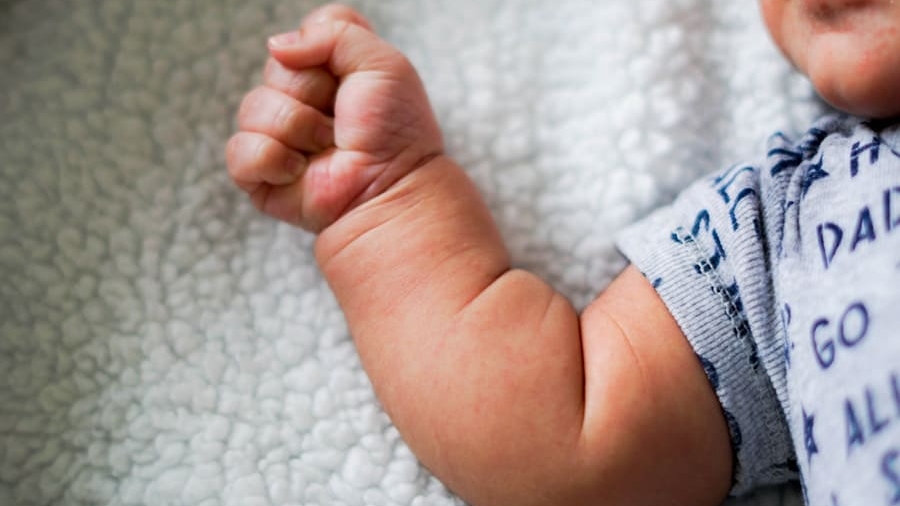In recent years, the advent of wearable technology has revolutionized various sectors, including healthcare. Among the most promising applications of this technology is the monitoring of vital signs in infants. Wearable devices designed specifically for this purpose have emerged as essential tools for parents and healthcare providers alike.
These devices can track critical health metrics such as heart rate, respiratory rate, temperature, and oxygen saturation, providing real-time data that can be crucial for early detection of potential health issues. The integration of advanced sensors and wireless communication technologies has made it possible to continuously monitor an infant’s health status without the need for invasive procedures or constant hospital visits. The significance of these wearable devices extends beyond mere convenience; they represent a paradigm shift in how infant health is managed.
Traditionally, monitoring vital signs in infants required frequent visits to healthcare facilities, which could be stressful for both the child and the parents. With wearable technology, parents can keep a close eye on their child’s health from the comfort of their home, allowing for timely interventions when necessary. This shift not only enhances parental peace of mind but also empowers caregivers with actionable insights into their child’s well-being.
Key Takeaways
- Wearable devices for infant vital sign monitoring are becoming increasingly popular due to their convenience and potential to provide real-time data.
- Monitoring infant vital signs is crucial for early detection of health issues and timely intervention, leading to better outcomes and reduced mortality rates.
- Wearable devices use sensors to track vital signs such as heart rate, respiratory rate, and body temperature, providing continuous monitoring without disrupting the infant’s routine.
- The advantages of using wearable devices for infant vital sign monitoring include improved accuracy, convenience for parents and caregivers, and the ability to track trends over time.
- Challenges and limitations of wearable devices for infant vital sign monitoring include accuracy of measurements, potential for false alarms, and concerns about data security and privacy.
The Importance of Monitoring Infant Vital Signs
Monitoring vital signs in infants is critical due to their unique physiological characteristics and vulnerability to various health conditions. Infants are at a higher risk for respiratory distress, infections, and other acute medical issues that can escalate rapidly. Early detection of abnormal vital signs can lead to prompt medical intervention, which is often crucial in preventing severe complications or even fatalities.
For instance, a sudden drop in oxygen saturation levels can indicate respiratory distress, necessitating immediate medical attention. Therefore, continuous monitoring can serve as an early warning system, alerting caregivers to potential problems before they become life-threatening. Moreover, the importance of monitoring extends beyond acute conditions; it also plays a vital role in managing chronic health issues.
Infants with congenital heart defects or other long-term health concerns require regular monitoring to ensure their condition remains stable.
This continuous flow of information can lead to more personalized care strategies, ultimately improving health outcomes for vulnerable infants.
How Wearable Devices Work to Monitor Infant Vital Signs

Wearable devices for infant vital sign monitoring typically incorporate a range of sensors that measure various physiological parameters. These sensors can include photoplethysmography (PPG) sensors for heart rate monitoring, accelerometers for movement tracking, and thermistors for temperature measurement. The data collected by these sensors is transmitted wirelessly to a connected device, such as a smartphone or tablet, where it can be analyzed and displayed in real-time.
Some advanced devices even utilize machine learning algorithms to interpret the data and provide insights into trends or anomalies.
Many wearable monitors are equipped with alert systems that notify parents or caregivers when a vital sign falls outside of predefined thresholds.
For example, if an infant’s heart rate exceeds a certain limit, the device may send an immediate alert to the caregiver’s smartphone. This feature is particularly beneficial during sleep periods when parents may not be able to monitor their child closely. Additionally, some devices offer cloud-based storage solutions that allow healthcare providers to access historical data for more comprehensive assessments.
Advantages of Using Wearable Devices for Infant Vital Sign Monitoring
The advantages of using wearable devices for monitoring infant vital signs are manifold. One of the most significant benefits is the ability to provide continuous monitoring without the need for invasive procedures. Traditional methods often involve attaching electrodes or other devices directly to the skin, which can be uncomfortable for infants and may lead to skin irritation.
In contrast, many wearable devices are designed to be non-intrusive and comfortable, allowing infants to move freely while still being monitored. Another key advantage is the empowerment of parents through access to real-time data. With wearable technology, parents can track their infant’s vital signs at any time and from anywhere, fostering a sense of control over their child’s health.
This accessibility can reduce anxiety and uncertainty, particularly for first-time parents who may be more apprehensive about their child’s well-being. Furthermore, the ability to share this data with healthcare providers enhances communication and collaboration in managing the infant’s health.
Challenges and Limitations of Wearable Devices for Infant Vital Sign Monitoring
Despite the numerous advantages of wearable devices for infant vital sign monitoring, several challenges and limitations persist. One significant concern is the accuracy and reliability of the data collected by these devices. While many wearable monitors are designed with advanced sensors, factors such as movement artifacts or improper placement can lead to inaccurate readings.
This issue is particularly critical in infants who may not remain still during monitoring periods. Ensuring that these devices provide consistent and reliable data is essential for effective health management. Another challenge lies in the integration of wearable technology into existing healthcare systems.
While many parents may embrace the use of these devices, healthcare providers must also adapt to this new paradigm. This includes developing protocols for interpreting data from wearable devices and determining how it fits into traditional clinical assessments. Additionally, there may be disparities in access to technology among different populations, raising concerns about equity in healthcare delivery.
Current and Future Applications of Wearable Devices for Infant Vital Sign Monitoring

Currently, wearable devices are being utilized in various settings, from home monitoring to hospital environments. In neonatal intensive care units (NICUs), advanced wearable monitors are employed to track vital signs in premature or critically ill infants continuously. These devices help healthcare providers make timely decisions regarding treatment adjustments based on real-time data.
Outside of clinical settings, parents are increasingly using consumer-grade wearable monitors to keep tabs on their infants’ health at home. Looking ahead, the future applications of wearable devices for infant vital sign monitoring are promising. Innovations in sensor technology and artificial intelligence are expected to enhance the capabilities of these devices significantly.
For instance, future wearables may incorporate advanced algorithms that not only monitor vital signs but also predict potential health issues based on historical data patterns. Additionally, as telemedicine continues to grow in popularity, wearable devices could play a crucial role in remote patient monitoring, allowing healthcare providers to offer consultations based on real-time data from home.
Ethical and Privacy Considerations in Using Wearable Devices for Infant Vital Sign Monitoring
The use of wearable devices for monitoring infant vital signs raises important ethical and privacy considerations that must be addressed as this technology becomes more widespread. One primary concern is the security of sensitive health data collected by these devices. Parents must trust that their child’s health information will be protected from unauthorized access or breaches.
Manufacturers must implement robust security measures to safeguard this data while ensuring compliance with regulations such as HIPAA (Health Insurance Portability and Accountability Act) in the United States. Additionally, there are ethical implications surrounding informed consent and parental autonomy. Parents should be fully informed about how their child’s data will be used and shared before using wearable devices.
This includes understanding potential risks associated with data sharing with third parties or healthcare providers. Striking a balance between leveraging technology for improved health outcomes and respecting privacy rights is essential in fostering trust between parents and healthcare systems.
The Impact of Wearable Devices on Infant Vital Sign Monitoring
The impact of wearable devices on infant vital sign monitoring is profound and multifaceted. These technologies have transformed how parents and healthcare providers approach infant health management by enabling continuous monitoring and real-time data access. As advancements continue in sensor technology and data analytics, the potential for improving health outcomes for infants will only grow stronger.
While challenges remain regarding accuracy, integration into healthcare systems, and ethical considerations, the benefits offered by wearable devices cannot be overlooked. They empower parents with knowledge about their child’s health while facilitating timely interventions when necessary. As we move forward into an era where technology plays an increasingly central role in healthcare, wearable devices will undoubtedly continue to shape the landscape of infant care in meaningful ways.
A related article discussing the top 5 smartwatches of 2023 can be found at this link. This article provides insights into the latest advancements in wearable technology, which is relevant to the discussion on how wearable devices are improving infant vital sign monitoring. The top smartwatches of 2023 may offer features that could potentially enhance the monitoring of infants’ vital signs, further highlighting the importance of wearable devices in healthcare.
FAQs
What are wearable devices for infant vital sign monitoring?
Wearable devices for infant vital sign monitoring are small, lightweight devices that can be attached to an infant’s body to continuously monitor their vital signs such as heart rate, respiratory rate, and oxygen saturation.
How do wearable devices improve infant vital sign monitoring?
Wearable devices improve infant vital sign monitoring by providing continuous and real-time data, allowing healthcare providers to detect any abnormalities or changes in the infant’s vital signs promptly. This can lead to early intervention and improved outcomes for the infant.
What are the benefits of using wearable devices for infant vital sign monitoring?
Some benefits of using wearable devices for infant vital sign monitoring include improved accuracy and reliability of vital sign measurements, reduced need for invasive monitoring procedures, and increased convenience for both healthcare providers and parents.
Are wearable devices for infant vital sign monitoring safe to use?
Wearable devices for infant vital sign monitoring are designed to be safe for use on infants. They are typically non-invasive and are designed to be comfortable for the infant to wear. However, it is important for healthcare providers and parents to follow the manufacturer’s guidelines for proper use.
What are some examples of wearable devices for infant vital sign monitoring?
Examples of wearable devices for infant vital sign monitoring include pulse oximeters that can be worn on the infant’s foot or hand, as well as wearable patches or bands that can monitor multiple vital signs simultaneously. These devices are designed to be unobtrusive and comfortable for the infant to wear.

